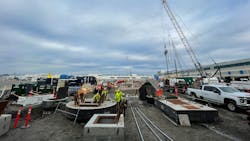Dewatering can typically be anticipated on any construction site, no matter the location. For Portland International Airport’s renovations near the Columbia River Delta, the project’s general contractor — Hoffman-Skanska LLC — had to consider the best option for dewatering the construction site of a new main sewer interceptor lift station.
Pre-pandemic, Portland International Airport served 20 million passengers per year and expects that number to grow to 35 million passengers each year by 2025. The Port of Portland launched a series of renovations, named the PDX Next Project, in early 2021. The project includes a new main terminal, accompanied by a redesign of Concourses E and B, as well as a new rental car facility.
The future design of the airport with its timber roofing, natural lighting, and local foliage was conceived by ZGF Architects.
Hoffman Construction has worked with the Port of Portland for decades, so construction on an operating airport was nothing new for them. Hoffman is the largest contractor from the Pacific Northwest — but, due to the complexity and size of this project, the Portland-based company teamed up with Skanska, a global construction and development firm. Together, the groups formed Hoffman-Skanska LLC to complete this joint venture.
A Deep Challenge
Supplying a new main terminal to a fully functioning and operating airport consists of many moving parts, including space constraints. While the public anticipates a new design and more traveling opportunities,
the engineers must focus on the design and construction that will make it all possible.
“This is a complicated, long-lasting, and overall large project which includes demoing the existing terminal, then rebuilding it double the size in the same existing footprint,” Taylor Talent, a project engineer for Hoffman-Skanska said.
The new terminal would increase the airport’s ability to serve 15 million more passengers but, to make that possible, the airport’s main sewer interceptor lift station needed to be replaced. Built at sea level, the Portland International Airport sanitary sewer system relies heavily on lift stations. While these previous projects had their share of complicated design scenarios, none were as significant as PDX Next.
“There’s a lot of equipment to place under the surface of an active airport,” said Andy Dake, an engineer for Romtec Utilities, the company responsible for designing and supplying several of the area’s existing lift stations. “One of the most challenging parts of this project is the underground design.”
Neither the deep wet well, nor the valve vault required on this project are what Romtec Utilities would consider a typical design — plus, this lift station would be pumping a lot of water from its location directly outside the gate windows and between two concourses.
Dealing with High Water
Working within a tight footprint, Hoffman-Skanska had to determine the best way to install a 12 feet wide by 35 feet deep pumping system into an area with very high groundwater. Rather than try to pump the groundwater elsewhere using traditional dewatering methods, project engineers decided to work with ground freezing service SoilFreeze Inc. to hold groundwater at bay during construction.
For the PDX Next project, SoilFreeze worked to freeze liquid in the excavation pits with minimal environmental impact. The process included driving 3-inch hollow pin piles 40 to 60 feet underground. Inside the steel piles, SoilFreeze placed high-density polyethylene (HDPE) tubes to allow a chilled brine to circulate into the exterior pipe and flow out of the interior pipe.
Then, the HDPE tubes were hooked to manifold heads to create a refrigerant loop. Last, SoilFreeze pumped the saltwater brine, causing it to circulate through the loop and freeze the surrounding soil.
Offering a safe, easy, and effective solution, groundwater freezing made a significant impact to the PDX construction site and held the groundwater at bay while contractors got to work.
This approach was the perfect solution to a project with large excavation pits and extreme groundwater conditions, such as the PDX NEXT Main Terminal Core Development Project.
Today, the new Portland International Airport is on schedule for completion in 2025. Soon, travelers will have the opportunity to explore the new terminal and enjoy the fresh architecture reminiscent of the Pacific Northwest Forest — meanwhile, a brand-new main sewer interceptor lift station will be operating underneath the surface. WW
Published in WaterWorld magazine, March 2022.



